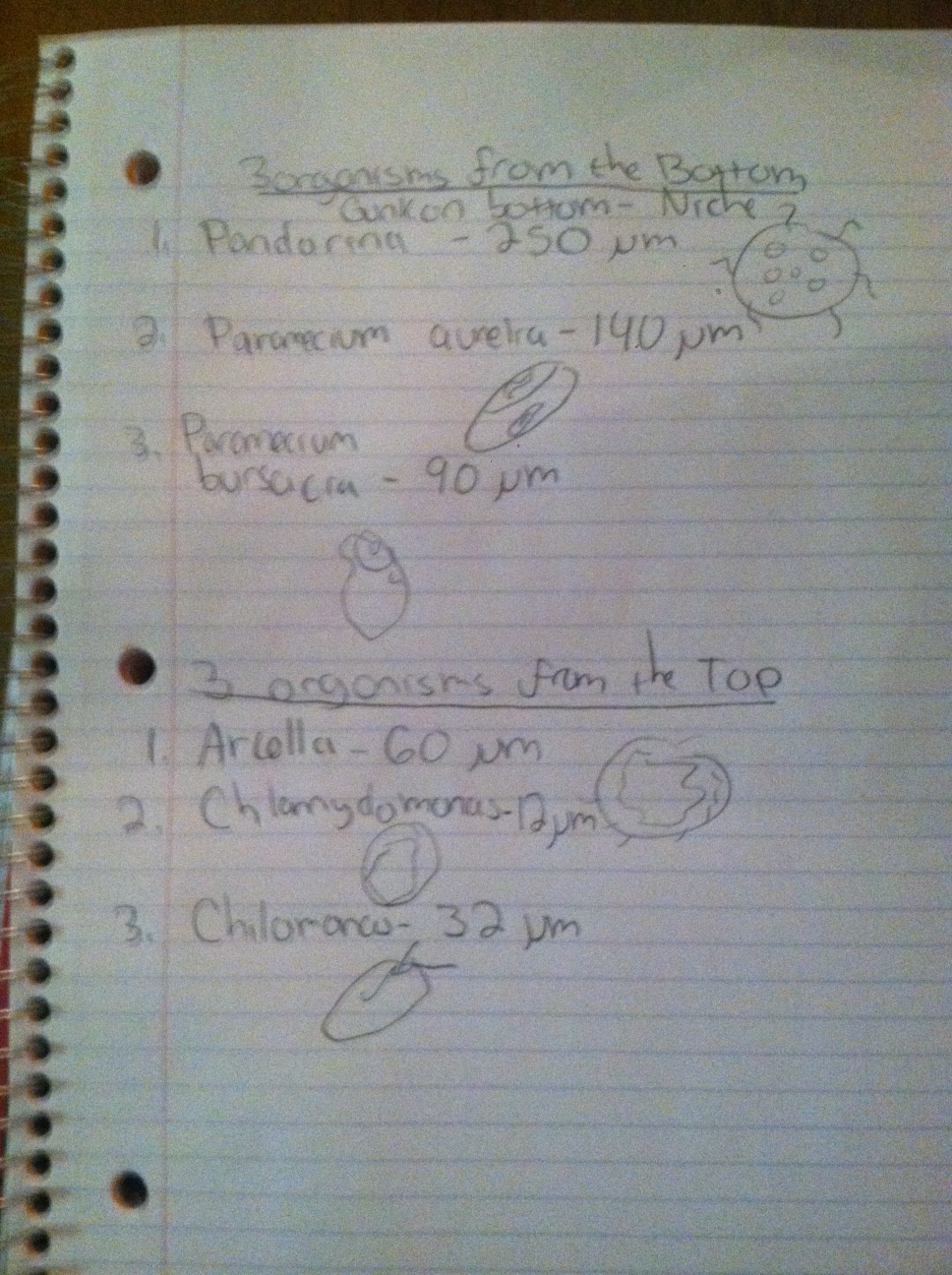User:Jessica Kerpez/Notebook/Biology 210 at AU: Difference between revisions
(New page: Describe the general characteristics of the transect: location, topography, etc. : The transect was located in a grassy area in the middle of two of three large trees near the Washington S...) |
No edit summary |
||
| Line 1: | Line 1: | ||
'''February 9th, 2014''' | |||
LAB 2: Identifying Algae and Protists | |||
There was a clear transformation in our Hay Infusion Culture. The smell of the culture was musky and foul. There was a layer of film that had developed at the top of the jar. There was a thick layer of sludge that was resting at the bottom of the jar, and small spots of green mold. | |||
Organisms near vs away from the plants will different because the species in the area are exposed to two different environments. Species that live far away from the plant may eat the mold that is resting on the bottom of the jar, while species near the plant could feed upon the plant matter. | |||
We got our samples from the top film layer and from the sludge resting at the bottom: | |||
[[Image:LAB PIC.jpg]] | |||
3 Organisms from Bottom Niche- Gunk on Bottom 1. Pandorina- 250 micrometers, green algae, pandorina genus, mobile using flagella. 2. Paramecium Aurelia-140 micrometers, paramecium genus, mobile using cilia. 3. Paramecium Busaria- 90 micrometers, protozoan, paramecium genus, mobile mobile. | |||
3 Organisms from Top Niche-top film layer of water 1. Arcella- 60 micrometers, Arcella genus, mobile 2. Chlamydomonas- 12 micrometers, green algae, Chlamydomonas genus, mobile with flagella 3. Chilomonas - 32 micrometers, chryptophyte, protozoa, chilomonas genus, mobile with flagella | |||
'''J.K''' | |||
'''1.31.14''' | |||
LAB 1 | |||
Describe the general characteristics of the transect: location, topography, etc. : The transect was located in a grassy area in the middle of two of three large trees near the Washington Seminary. On either side of the grassy area covered in dirt, leaves, and sticks stood two tall trees. The ground was completely covered in leaves because they had fallen from the large trees. The ground and soil was slightly damp from rainfall. In the middle of these two trees was a picnic table and a small, round tennis ball. We also witnessed a small yellow-crested bird perch upon one of the tall trees. | Describe the general characteristics of the transect: location, topography, etc. : The transect was located in a grassy area in the middle of two of three large trees near the Washington Seminary. On either side of the grassy area covered in dirt, leaves, and sticks stood two tall trees. The ground was completely covered in leaves because they had fallen from the large trees. The ground and soil was slightly damp from rainfall. In the middle of these two trees was a picnic table and a small, round tennis ball. We also witnessed a small yellow-crested bird perch upon one of the tall trees. | ||
| Line 19: | Line 54: | ||
reproduction specialization isogamy oogamy oogamy | reproduction specialization isogamy oogamy oogamy | ||
'''J.K.''' | |||
Revision as of 14:31, 9 February 2014
February 9th, 2014
LAB 2: Identifying Algae and Protists
There was a clear transformation in our Hay Infusion Culture. The smell of the culture was musky and foul. There was a layer of film that had developed at the top of the jar. There was a thick layer of sludge that was resting at the bottom of the jar, and small spots of green mold.
Organisms near vs away from the plants will different because the species in the area are exposed to two different environments. Species that live far away from the plant may eat the mold that is resting on the bottom of the jar, while species near the plant could feed upon the plant matter.
We got our samples from the top film layer and from the sludge resting at the bottom:
3 Organisms from Bottom Niche- Gunk on Bottom 1. Pandorina- 250 micrometers, green algae, pandorina genus, mobile using flagella. 2. Paramecium Aurelia-140 micrometers, paramecium genus, mobile using cilia. 3. Paramecium Busaria- 90 micrometers, protozoan, paramecium genus, mobile mobile.
3 Organisms from Top Niche-top film layer of water 1. Arcella- 60 micrometers, Arcella genus, mobile 2. Chlamydomonas- 12 micrometers, green algae, Chlamydomonas genus, mobile with flagella 3. Chilomonas - 32 micrometers, chryptophyte, protozoa, chilomonas genus, mobile with flagella
J.K
1.31.14
LAB 1
Describe the general characteristics of the transect: location, topography, etc. : The transect was located in a grassy area in the middle of two of three large trees near the Washington Seminary. On either side of the grassy area covered in dirt, leaves, and sticks stood two tall trees. The ground was completely covered in leaves because they had fallen from the large trees. The ground and soil was slightly damp from rainfall. In the middle of these two trees was a picnic table and a small, round tennis ball. We also witnessed a small yellow-crested bird perch upon one of the tall trees.
List the abiotic and biotic components:
Abiotic: Tennis ball, picnic table, soil
Biotic: Trees, leaves, bird
Table 1 Evolutionary Specialization of Members of the Volvocine Line
Characteristic Chlamydomonas Gonium Volvox
Number of cells 2 3 1
Colony size 6 5 1
special function motile still still
reproduction specialization isogamy oogamy oogamy
J.K.
